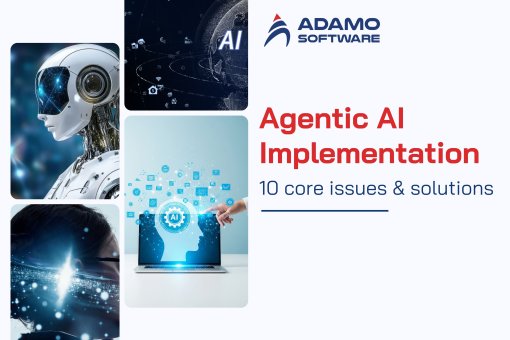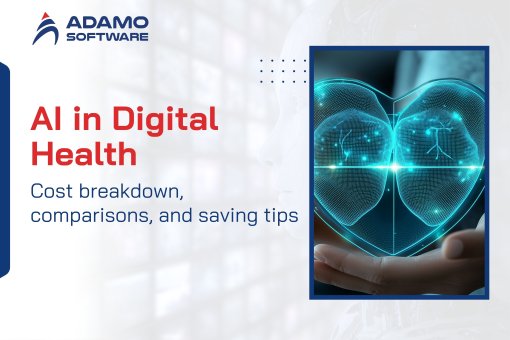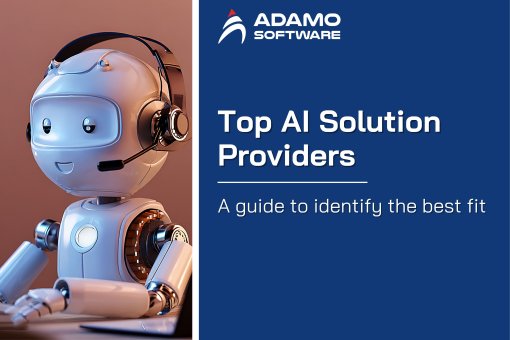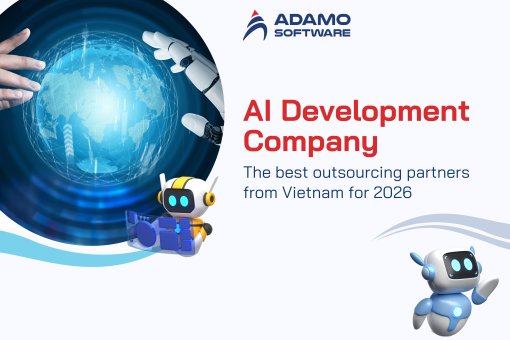How to Build AI Software: Everything you need to know before start
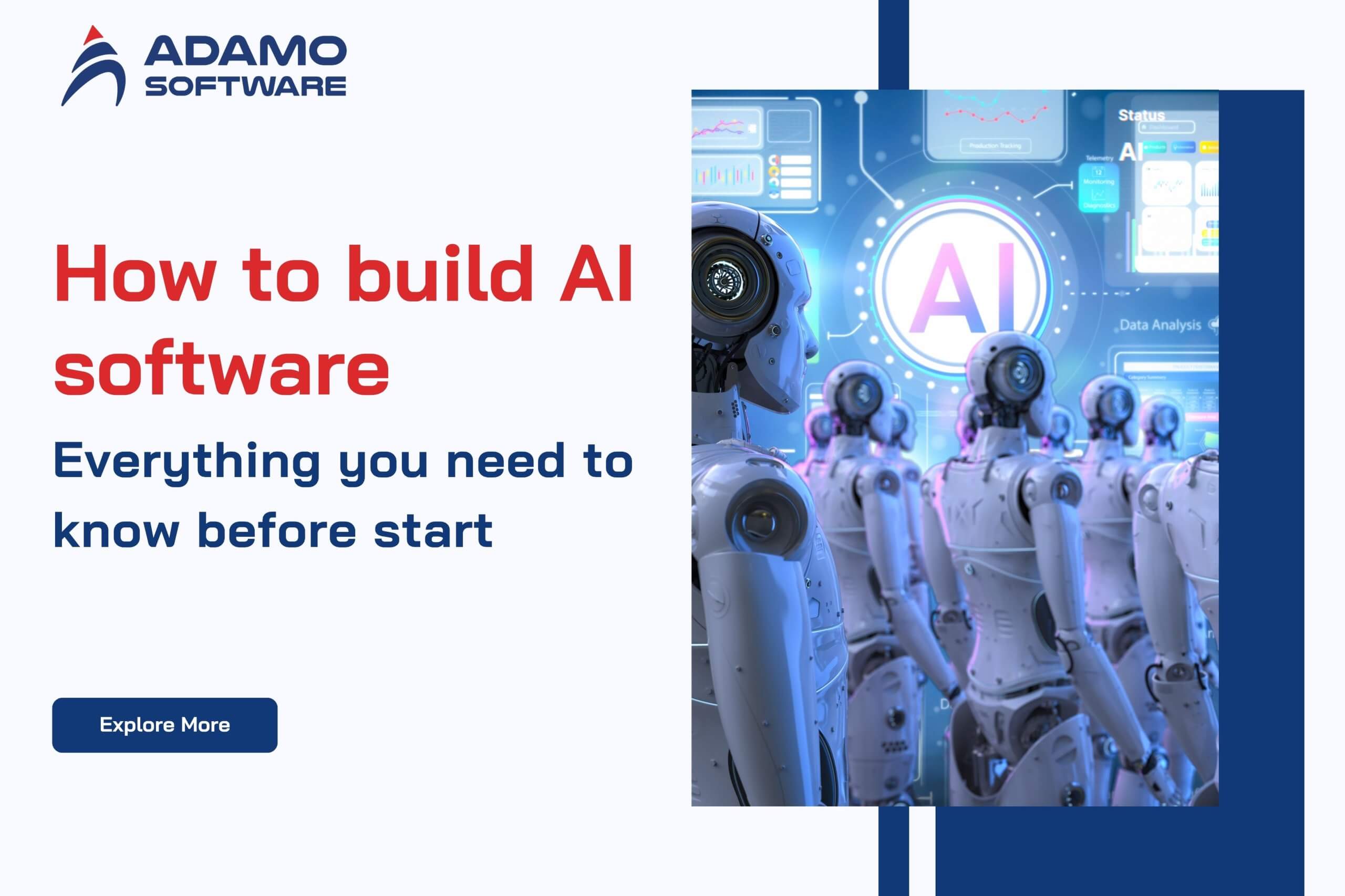
Wondering how to build AI software? Explore core elements, development tips, and strategies to launch scalable AI-powered applications.
Artificial intelligence is one of the most game-changing phenomena in business today. From automating daily tasks to creating new user experiences, AI is changing how companies grow and compete. For entrepreneurs and enterprises alike, learning how to build AI software is the gateway to unlocking these opportunities.
In this guide, we’ll discuss the why behind businesses investing in AI software and the real-life benefits that it offers. We’ll go through the basic building blocks of how to build AI software, and give a step-by-step approach for how to achieve it. You’ll also be able to learn from Adamo’s experience in AI software development and find ideas to help you get inspired for your own.
Here’s a glimpse of what we’re gonna learn together through this blog:
- Why should businesses invest in AI Software?
- What are the benefits of AI Software Development?
- How to Build AI Software: Core Components You Need to Know
- Step-by-Step Guide on How to Build AI Software
- AI Software Development: Adamo’s Proven Expertise
- AI App Development: 3 Fresh Product Ideas Worth Building
I. Why should businesses invest in AI Software?
When learning how to build AI software, the first question is always why it is essential. Businesses today are scrambling to adopt AI for good reasons. It helps provide users more value, allows companies to be competitive in the market, and eventually brings greater profitability.
According to Accenture, thanks to AI, some developed countries will potentially double their economic growth rate by 2035. On top of that, Statista estimates that the global market for AI software is expected to be valued at $126B in 2025. Besides, the adoption is expected to grow at a CAGR of 36.6% from 2024 to 2030. These numbers clearly show that it is time to get serious about AI.
The impact is already seen in the actual applications. AI algorithms enable processing massive datasets faster than humans and can produce more accurate insights. Chatbots, for example, can answer customer questions twenty-four hours daily, allowing staff to work on more complex requirements. Predictive analytics tools help forecast sales trends and customer behaviour, while automated marketing campaigns can help increase efficiency and ROI.
With a lot of tangible benefits, investing in AI software and understanding how to build AI software is not just a trend. For startups and software product companies, it’s a wise way to innovate and achieve success in the long run.
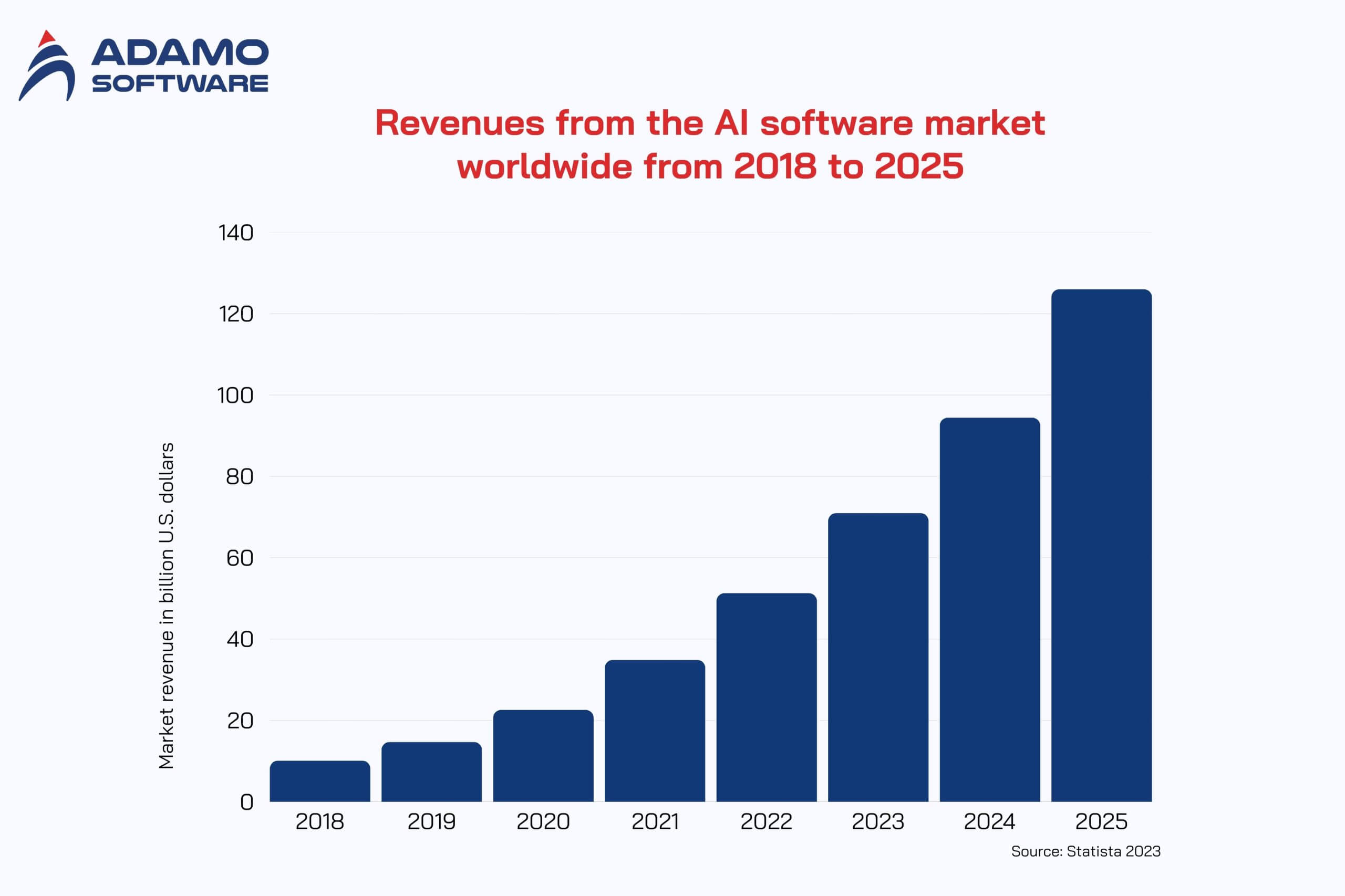
II. What are the benefits of AI Software Development?
For anyone looking at how to build AI software, it is the real excitement of what it will mean for business and the users. These are not abstract concepts but tangible results that transform operations, make them more efficient and provide better customer experiences.
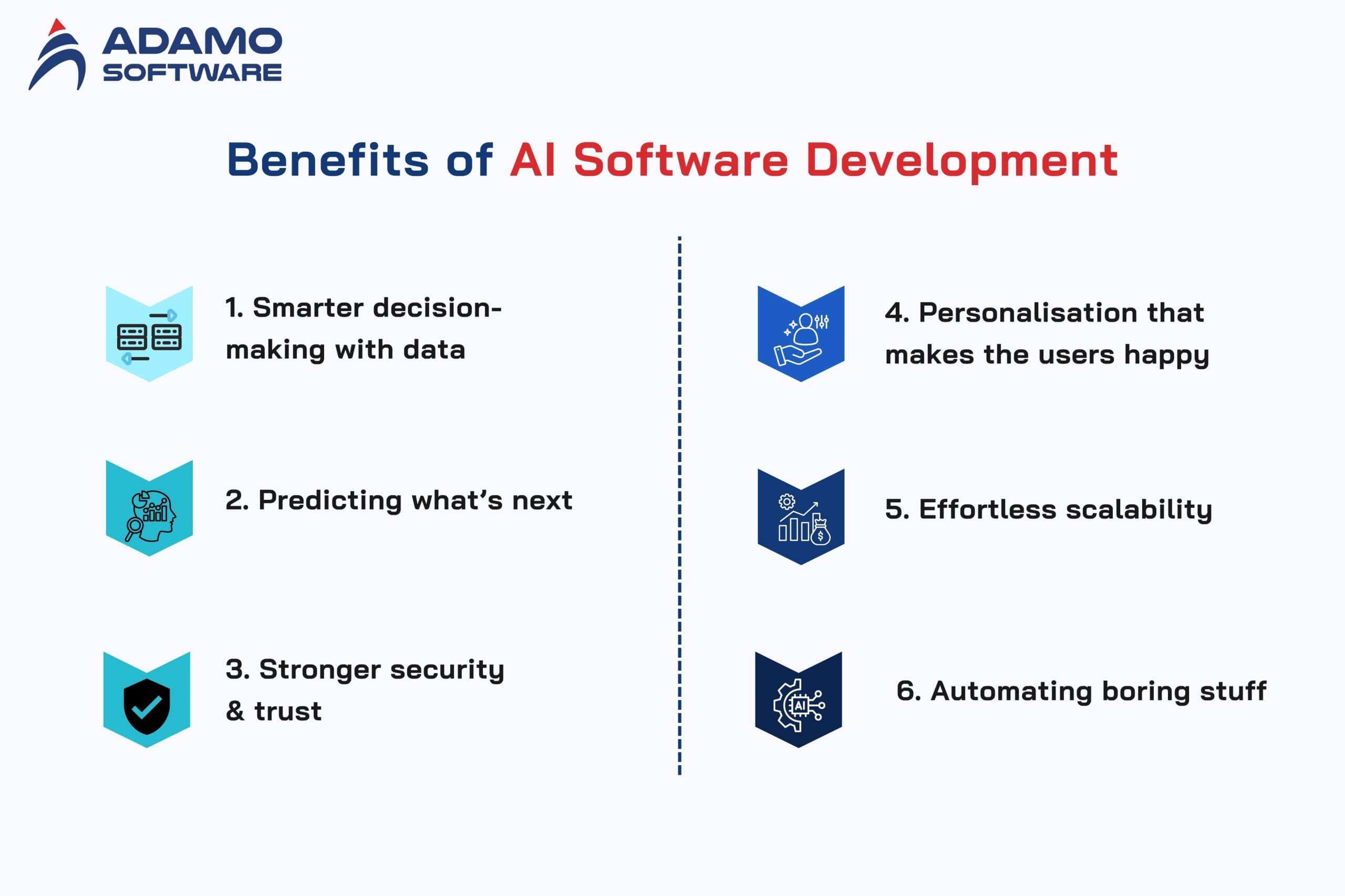
By combining machine learning and natural language processing, artificial intelligence apps can automate processes, personalise interactions, and streamline workflows. This will then result in greater growth and smarter decision-making.
Here are the major benefits to be expected while learning how to make AI software:
- Smarter decision-making with data: Use data insights to make decisions based on the insight, not guesses.
- Predicting what’s next: See what’s coming and how customers are likely to behave with predictive analytics.
- Stronger security and trust: Protect sensitive data and give your users security.
- Personalisation that makes the users happy: Create personalised experiences to increase loyalty.
- Effortless scalability: Maintain app performance as your app scales.
- Automating the boring stuff: Save time and save money by reducing the number of tasks that are performed over and over again.
1. Smarter decision-making using data
Guesswork just does not have a place in today’s market. AI allows enterprises to analyse big data to match products with the needs of customers and the market. This helps reduce risk, avoid costly missteps and allows applications to stand out.
2. Predicting what’s next
Predictive analytics is one of the most useful applications for developing AI software. It enables the business to anticipate changes in customer behaviour or market trends. From being able to forecast demand to identifying churn, AI gives companies a leg up.
3. Stronger security and trust
Data breaches are increasing, and security is therefore a priority. AI helps to increase protection by advanced threat detection and swift response. For finance, healthcare or any regulated industry, this is critical for compliance reasons and for establishing a long-term user trust.
4. Personalisation that makes the users happy
Modern users are demanding apps that understand them. AI allows for personalised recommendations, content, and interactions that feel relevant and interesting. ChatGPT is a good example of how customised replies can become part of why people become long-term users.
5. Effortless scalability
Growth must never be at the expense of performance. AI simplifies scaling by distributing loads on the servers and making the search process automatic. This keeps the performance consistent with the growing number of users.
6. Automating the boring stuff
Repetitive tasks drain the resources of both businesses and users. AI can automate or streamline many of these processes, saving time and money internally and lowering frustration in the users’ day-to-day routines.
Ready to Outsource?
Get top-tier IT talent without the hassle. Contact us now!
III. How to build AI Software: Key elements
When businesses are looking into how to build AI software, success depends on combining the right technologies and practices. Each element has a vital role to play in making your solution intelligent, reliable, and scalable. Being aware of these components provides you with the basis for designing AI applications that deliver real value.
Here are the primary components you’ll need to take into consideration when learning how to build AI software:
- Data collection and preparation: The data collection and preparation step sets up a strong foundation using clean and structured datasets.
- Machine learning (ML): The Brain behind Adaptive and intelligent behaviour.
- Deep learning: Neural networks for advanced, big data problem solving.
- Natural language processing (NLP): Helps your app to understand and use human language.
- Computer vision: Helps your AI analyse and understand visual data.
- Expert systems: Simulate the decision-making of experts in specialised fields.
- AI model training: Teaches your AI to make predictions and decisions.
- Ethics and bias awareness: Keeps your AI fair, transparent and accountable.
- Security and compliance: Helps to secure sensitive data and ensure compliance with regulations.
1. Data Collection and Preparations
The first step in building AI software is gathering good data. Clean, structured and well-labelled data sets are critical to effectively training models. Without good data preparation, even the best algorithms will not go far.
2. Machine learning (ML)
The key engine of an AI software is machine learning. It allows systems to recognise patterns, adapt, and evolve without the need to code constantly. Any of the guides on how to build AI software emphasises ML as the basis of intelligent features.
3. Deep learning
A subset of ML, deep learning, involves layered neural networks when analysing large data sets. If you’re researching how to build AI software for a more advanced need, deep learning is often the technology of choice. This can especially be helpful for things like medical imaging or fraud detection.
4. Natural language processing (NLP)
NLP enables your AI to comprehend and reply to human language. From chatbots to real-time translations, NLP is a must when learning how to build an AI software that interacts properly with people.
5. Computer vision
Computer vision is what provides AI with visual recognition. Whether for retail, healthcare, or security, including this component while learning how to build AI software is crucial. It allows applications to process and interpret photos, videos or real-time feeds from cameras.
6. Expert systems
Expert systems are imitations of professional decision-making in particular areas. When planning to develop AI software for fields like law or healthcare, these systems can help insert valuable and specialised knowledge into your product.
7. AI model training
Training is the way to make intelligence out of data. In this stage of AI software development, you input datasets into your model so it can accurately learn to make predictions and decisions. A well-trained employee is the key to ensuring reliable performance.
8. Ethics and bias awareness
No guide on how to build AI software will be complete without looking at fairness. Identifying bias in datasets, promoting transparency, and prioritising accountability are all important in ensuring responsible AI systems.
9. Security and compliance
The final piece of how to build Artificial Intelligence software is protecting user trust. Strong security measures and regulatory compliance help to protect sensitive information, which is crucial in certain industries such as finance and healthcare.
IV. Step-by-step guide on how to build AI software
Turning an AI idea into a working product is not only about coding skills. It’s a process that’s structured in a way that each stage builds on the next stage. Below are the main steps that you’ll need to follow when working out how to build AI software:
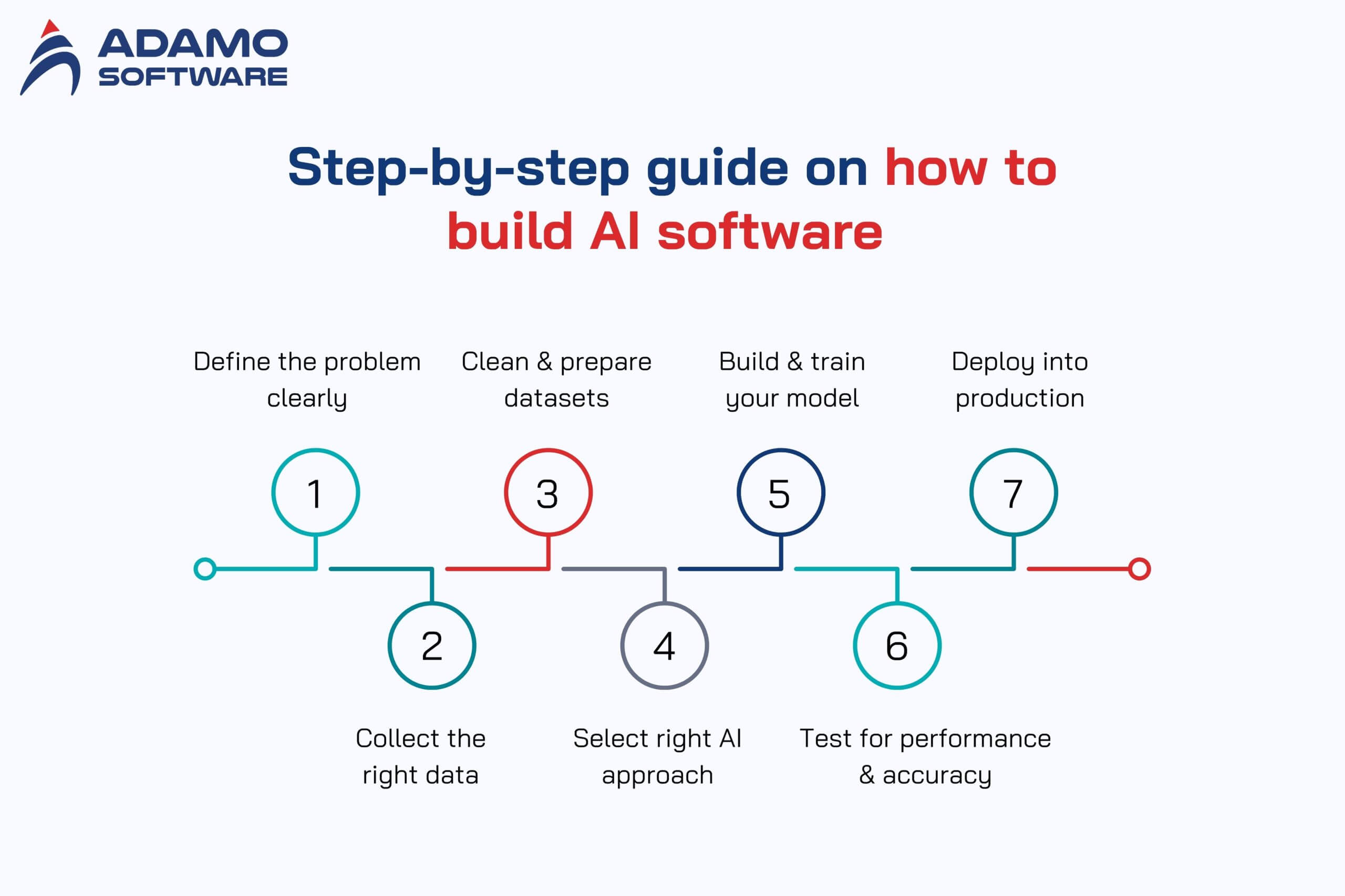
- Define the problem clearly: Understand the problem you’re trying to solve and what value AI can provide.
- Collect the right data: Get good data that is relevant to your use case
- Clean and Prepare datasets: Cleaning and organising your raw data in a standard form, labelling and organising your dataset for training.
- Select the right AI approach: Choose between the machine learning, NLP, computer vision or other approaches.
- Build and train your model: Input data and use frameworks or no-code tools to build your AI.
- Test for performance and accuracy: Test the model on new data to ensure it performs well and accurately.
- Deploy into production: Integrate your trained AI into production systems or apps.
1. Define the Problem
Every successful AI project, and every guide on how to build AI software, starts with the identification of a particular problem. The better the scope, the easier it is to design a solution. Retailers may apply AI to predict shopping behaviour, and healthcare providers may specialise in identifying scan patterns. A good problem statement keeps the whole process on course.
2. Collect the right data
AI models are only as strong as the data on which they are based. When learning how to build AI software, it’s essential to collect information that is relevant, diverse and representative of your target problem. This could be structured data, such as spreadsheets, or unstructured data such as text, images or videos that need to be processed.
3. Clean and prepare datasets
Raw data almost always has to be refined. Cleaning, duplicating, fixing gaps, and normalising formats are vital steps in how to build AI software effectively. It’s also important to label entries correctly and split datasets into training, validation, and test sets for fair future evaluations.
4. Select the Right AI approach
Choosing the right AI approach is very critical. Machine learning is best suited for predictions, NLP for conversational interfaces or sentiment analysis and computer vision for analysing images or videos. Matching the technology to the problem is one of the key lessons in how to build AI software efficiently.
5. Build and Train Your Model
This stage is where data is converted into intelligence. No code platforms like AutoML, SageMaker, TensorFlow and PyTorch provide flexibility to developers and ease for a beginner. Training is the process of teaching the system to recognise patterns and to fine-tune the outputs over time.
6. Test for Accuracy and Bias
A model is useless if it does not work reliably in the real world. Testing using unseen data is helpful in revealing errors, biases or overfitting. Compare results with industry benchmarks and utilise practical situations, like fraud detection, for results validation.
7. Launch into Production
The last step in how to build AI software is deployment, in which your AI model starts running in real systems. Whether integrated into a mobile app, SaaS platform, or internal tool, deployment is where the value of the AI can be seen and acted upon.
V. AI Software Development: Adamo’s expertise
At Adamo Software, we have accumulated years of experience delivering AI-powered solutions for businesses of all sizes—from fast-scaling startups to large enterprises. While client confidentiality prevents us from naming specific brands, our portfolio spans a wide spectrum of industries. Some of the advanced AI features we have successfully implemented include:
- Optical Character Recognition (OCR): transforming scanned or handwritten documents into structured, analyzable data.
- Internal Chatbots: enhancing organizational efficiency and automating support.
- AI-Powered Marketing Campaign Recommenders: boosting customer engagement with personalized content strategies.
- AI Travel Assistant Integration: embedding smart travel features directly into CMS platforms.
These capabilities reflect our strength in combining technical innovation with real-world impact, helping clients optimize processes, cut costs, and unlock new revenue streams.
Spotlight Case: AI-Driven Urine Diagnostics Platform
One of our most recent achievements is the development of an AI-powered urine diagnostics solution designed to revolutionize preventive healthcare.

Scope of the project
The platform enables real-time analysis of 10 essential health biomarkers in under one minute, delivering instant and personalized wellness insights. Our client partnered with Adamo Software to turn raw urinalysis data into actionable health guidance.
Challenges solved
- Translate raw urine test results into meaningful, real-time health advice.
- Track hydration levels via sodium and water balance.
- Monitor nutritional status by analyzing minerals such as calcium, magnesium, and zinc.
- Detect oxidative stress and ketones to assess metabolic health.
- Provide personalized action plans for diet, hydration, and wellness improvements.
Our approach
- Rapid AI diagnostic engine: built a high-performance AI system with 98% accuracy, capable of real-time analysis and integration with portable diagnostic devices.
- User-centric design: developed a mobile-compatible interface tailored for both healthcare professionals and everyday users, featuring clear visual reports and graphs.
- Personalized recommendations: integrated a dynamic wellness engine offering tailored advice on hydration, vitamin intake, and nutrition.
Technologies used
PHP, HTML, CSS, JavaScript, jQuery, Bootstrap, AWS, Robotflow API
This project is just one of hundreds of successful AI initiatives we have delivered worldwide. If you are exploring AI adoption – whether in healthcare, travel, or another domain – Adamo Software is ready to guide you with proven expertise and innovative thinking.
Contact us today to discover how our AI solutions can accelerate your business transformation.
Explore Our Tailor-made Software Development Solutions
We are confident in providing end-to-end software development services from fully-functioned prototype to design, MVP development and deployment.
VI. AI App Development: 3 Fresh Product Ideas Worth Building
Before asking yourself how to build AI software, you must decide what AI solution is worth building. The right idea isn’t always easy, especially in a competitive space.
To get the juices flowing, here are some new, non-generic app ideas using AI that may be the basis of your next startup:
- Smart nutrition companion: Adjusts the meal plans and diet recommendations based on personal health data.
- AI-driven finance advisor: Assists users in budgeting, investing, and managing money using machine learning.
- Intelligent event planner: Eases the process of organising events with intelligent recommendations and automation.
1. Smart Nutrition Companion
Health and diet are deeply individual, and it’s now possible to personalise these on a large scale through AI. By analysing a user’s lifestyle, health profile and food preferences, an AI nutrition app could make meal plan recommendations for balanced meals. It can also help suggest alternatives and track progress towards wellness goals.
2. AI-Driven Finance Advisor
Fintech remains a rich breeding ground of innovation. With machine learning, you might create an app which provides tailored investment strategies, automatic savings and risk assessment tools. A recent survey indicates that younger generations are already adopting AI for budgeting, better credit, and long-term planning, which is a very rich area.
3. Intelligent Event Planner
Event planning is stressful and time-consuming, but AI can help eliminate the chaos. A smart event app could recommend vendors, venues, and services based on user preferences and budget. Beyond recommendations, it has the potential to automate the process of sending invitations, managing RSVPs and building schedules. This will turn a complex process into a smooth experience.
VII. Conclusion
Learning how to build AI software isn’t just about learning how to use technology. It’s also about opening up real possibilities for growth, efficiency, and innovation.

With the right approach and trusted partners, companies can transform ideas into scalable AI solutions that will bring value to users. Whether it’s better decision-making, personalisation, or developing completely new products, the future is for those who are prepared to harness the power of AI.
FAQs
1. Is it possible to create an AI tool without coding?
Yes! You do not always need to be a programmer to build AI. Many guides on how to build AI software highlight no-code platforms that make the process simple. With these tools, you only need to feed the data into the machine, and it will train the AI model for you. Platforms like Google Cloud AutoML, AWS SageMaker, and MS Azure Machine Learning allow non-technical founders to get started quickly.
2. What tools and languages are utilised to develop an AI?
Python, by far, is the most popular programming language used for artificial intelligence, due to the plethora of libraries and frameworks available. Beyond Python, depending on the project’s focus, developers also use special tools for machine learning, natural language, and neural networks.
3. How can I ensure my AI product is ethical and trustworthy?
Responsible AI begins with the data. Since AI systems draw their knowledge from the information they’re fed, it’s important to reduce bias, protect user privacy, and remain transparent. For anyone exploring how to build AI software, this means testing models carefully, complying with regulations like GDPR, and explaining how decisions are made. Involving diverse voices from users to ethicists also helps ensure your AI software remains aligned with real-world needs and human values.
4. How long does it take to develop an AI app?
The development timeline depends on the project’s complexity, the amount of training data, and the application’s goals. On average:
- Simple features (like chatbots or image recognition): 3-6 months
- Medium complexity (customised AI models) 6-12 months
- High complexity (specialized or research-heavy systems): 9-12 months







